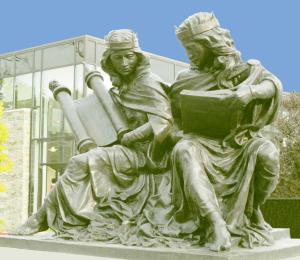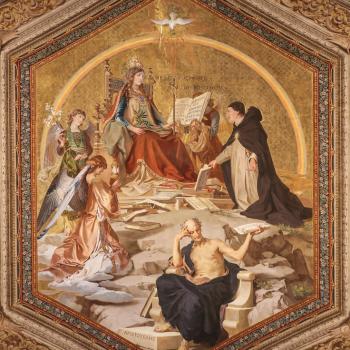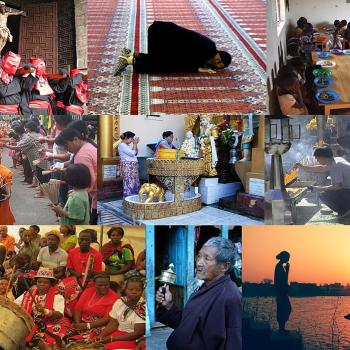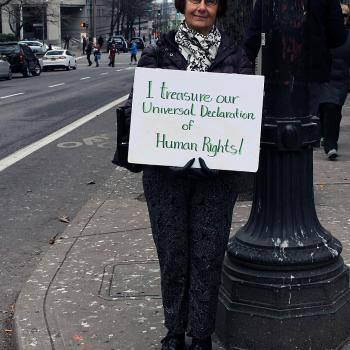
Nostra Aetate is a very important document from Vatican II. This is not because it creates a new theological position on non-Christian religions, but rather, because it revitalizes and confirms an element of Christian tradition which had been neglected and lost in modern times (especially after the Reformation). While Christians obviously do not agree with non-Christians in regard to all their beliefs and practices, Christianity has long accepted that the work of God in and with the rest of the world has led to all kinds of inspirations and truths to be found even in non-Christian faith traditions. Many early Christian apologists defended the Christian faith on the basis of the common heritage and faith Christians shared with non-Christians, pointing out that what non-Christians believed about God was not only are agreed upon by Christians, but was taken up by them and brought to their proper conclusion. Paul made a similar argument on Mars Hill, and as a result, Dionysius the Areopigate and others became believers. Instead of the hostile approach many Christians have treated non-Christian religions, we see that many early Christians had a much more positive dialogue with non-Christians; they tried to find ways to both show differences between various faiths, but also to highlight the universal truths they could and did find in them, using those universal truths for a positive indeed, affirmative engagement with non-Christians. Those who study the history of Christian theology will note there have always been those who are more cautious and hostile to non-Christian faiths, but also that many were more open to dialogue, and through that dialogue, actually learned from them, showing that Christian encounters with non-Christians could and did offer much to Christians. And, the more philosophical the thinker, the more likely they were to embrace this positive approach to non-Christian religion, for they realized if religion, as a category, is a good thing, then that value should be discerned not just within the Christian religion, but all religions. It is this kind of realization what serves as a foundational point for Nostra Aetate:
From ancient times down to the present, there is found among various peoples a certain perception of that hidden power which hovers over the course of things and over the events of human history; at times some indeed have come to the recognition of a Supreme Being, or even of a Father. This perception and recognition penetrates their lives with a profound religious sense.[1]
This sensibility is something we find Paul and early church fathers engaging. Christians certainly believe that there is something revealed to Christians which transcends all other revelation. They obviously believe that there can be and are beliefs held by other religions which Christians do not agree with (indeed, they can find sometimes, other faiths hold onto something which is in grave error). But they also can accept that non-Christians likewise hold to some truths, some which might even have been given to them by some sort of inspiration. These two positions should go together instead of being separated from each other. Taking one without the other will lead to some great problem. We cannot treat all religions are the same, for that would lead to all kinds of self-contradiction as various religions contradict each other, but on the other hand, we must not take an exclusive approach to religion where the truth is said to be found only within the Christian faith, thereby denigrating other faiths and the truths which they possess. Such an exclusive take would destroy many great theological texts, such as the Summa Theologica, which take into consideration, and use, truths, not just from the Christian tradition, but truths established by Jews, Muslims, and pagans. In this fashion, Nostra Aetate can be seen to be putting in words some of Aquinas’ methodology (and not just his, but a wide representation of thinkers like St. Justin Martyr, St Clement of Alexandria, St. Augustine, Boethius, Ficino, Solovyov, Bulgakov, Balthasar, et. al) when it indicated:
The Catholic Church rejects nothing that is true and holy in these religions. She regards with sincere reverence those ways of conduct and of life, those precepts and teachings which, though differing in many aspects from the ones she holds and sets forth, nonetheless often reflect a ray of that Truth which enlightens all men. Indeed, she proclaims, and ever must proclaim Christ “the way, the truth, and the life” (John 14:6), in whom men may find the fullness of religious life, in whom God has reconciled all things to Himself.) [2]
Once we accept this, we can understand why it is important for us to look to people of other faiths, to listen to them and their beliefs, even to learn from them. For the universal religious consciousness, which is a good, which is a part of what God uses to draw us in to grace, has produced all kinds of apprehensions of truth which should be honored and respected by us. If we are unwilling to listen to others and their beliefs, we will miss out, which is why we are told:
The Church, therefore, exhorts her sons, that through dialogue and collaboration with the followers of other religions, carried out with prudence and love and in witness to the Christian faith and life, they recognize, preserve and promote the good things, spiritual and moral, as well as the socio-cultural values found among these men. [3]
Vatican II, therefore, serves tradition and points to us to an element of it which we, as a communist, seemed to have forgotten or lost. We are now encouraged to learn from other faiths and traditions, to find the rays or seeds of truth which God gave to the whole world so that we can better understand our own relationship with God. Likewise, it reminded us, like the apologists, to understand the universal family of humanity, so as not to unjustly treat or abuse each other for differences of belief:
We cannot truly call on God, the Father of all, if we refuse to treat in a brotherly way any man, created as he is in the image of God. Man’s relation to God the Father and his relation to men his brothers are so linked together that Scripture says: “He who does not love does not know God” (1 John 4:8). [4]
Perhaps one of the greatest representations of the tradition brought back to our attention by Nostra Aetate was Nicholas of Cusa. He wrote a book on the need for people of diverse religions to come together in unity and bring about a peace between religions. The great diversity found within humanity led for the need for a diversity of religious tradition, but the unity of humanity showed the need to find a way to have some sort of unity in that diversity which, for Nicholas of Cusa, was to be found in the Christian faith, and indeed, in Christ. He did not think this meant we should deny that there was inspiration, prophets even, sent to people all around the world as the source of their religious traditions. Indeed, he thought that God could be seen at work at the foundation of many faith traditions, and he used that as the basis to show that people of different faiths should come and work together for peace:
Accordingly, You set over Your people different kings and different seers, called prophets—very many of whom, in their role as Your legates, instituted (in Your name) worship and laws and instructed an uneducated people. [Men] accepted these laws just as if You Yourself, the King of kings, had spoken to them face to face; they believed that they heard not kings and prophets but You Yourself in and through kings and prophets. Now, to various nations You sent various prophets and teachers—some at one time, others at another. But the earthly human condition has this characteristic: viz., that longstanding custom, which is regarded as having passed over into nature, is defended as the truth. In this way there arise great quarrels when each community prefers its own faith to another [faith].[5]
Thus, long before Vatican II, we see this tradition represented by one of the key intellectual and indeed religious figures of 15th century Catholicism. Nicholas was an important figure in the institutional church, as he was a papal legate for Pope Eugene IV, elevated to Cardinal by Nicholas V, and became the vicar-general of the papal states. He would not have been given honor and respect by Pope Eugene IV if Eugene thought he betrayed the Catholic faith. We are, therefore, free to see people of different faiths have elements of the truth, even as we can believe those truths were inspired truths, albeit, perhaps, imperfectly transmitted over time. Sadly, this inspirational, and invaluable take, was often not explained to the ordinary faithful, which is why they were surprised with what was taught at Vatican II. Indeed, before the council, many within the institutional church promoted a rather hostile approach to non-Christian faiths, one which suggested that Christianity had an exclusive claim to the truth, and once that position was held, it was easily used to subvert religious liberty and the toleration and respect which should have been shown to non-Christians. This is one of the reasons why Nostra Aetate was important. It reminded Christians of its greater tradition, pointing out that religious liberty and tolerance was often an important element of the way Christians engaged non-Christians.
Those who try to read Nostra Aetate as an abdication of tradition only confuse modern, a corrupted ideology, with the whole of Christian tradition. It was revolutionary, as they say, but not because it created a new idea which Christians never had before the council; rather, it is revolutionary because it fought against a grave error which many Christians were led to believe, an error which had them treat non-Christians with utter hatred and contempt as can be seen especially in the way Christians historically abused the Jews. Certainly, then, Nostra Aetate can be seen in stark contrast to what many had been led to believe, but what they believed was itself a corruption of the Christian tradition, which is why it had to be rejected at Vatican II.
[1] Nostra Aetate. Vatican translation. ¶2.
[2] Nostra Aetate. ¶2.
[3] Nostra Aetate. ¶2.
[4] Nostra Aetate. ¶5.
[5] Nicholas of Cusa, De Pace Fidei in Nicholas of Cusa’s De Pace Fidei and Cribratio Alkorani. Trans. Jasper Hopkins (Minneapolis: Arthur J. Banning Press, 1994), 34-5.
Stay in touch! Like A Little Bit of Nothing on Facebook.
If you liked what you read, please consider sharing it with your friends and family!
N.B.: While I read comments to moderate them, I rarely respond to them. If I don’t respond to your comment directly, don’t assume I am unthankful for it. I appreciate it. But I want readers to feel free to ask questions, and hopefully, dialogue with each other. I have shared what I wanted to say, though some responses will get a brief reply by me, or, if I find it interesting and something I can engage fully, as the foundation for another post. I have had many posts inspired or improved upon thanks to my readers.













